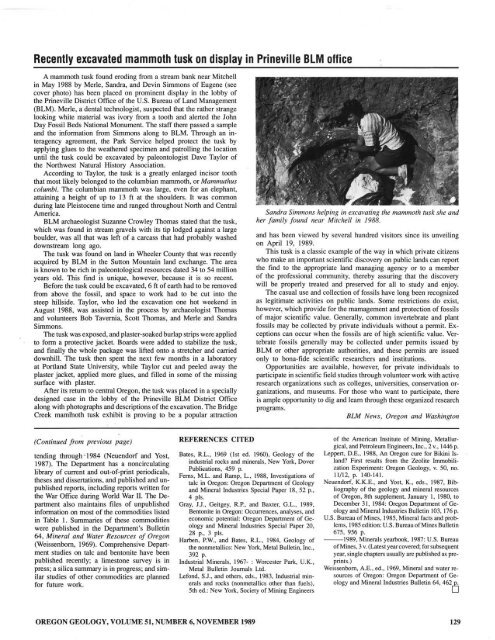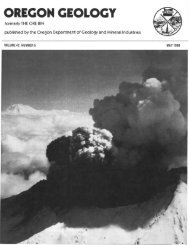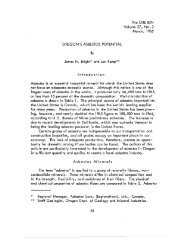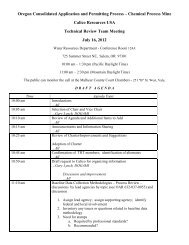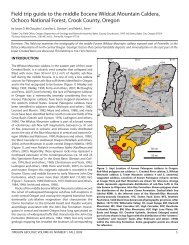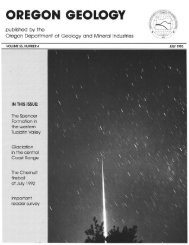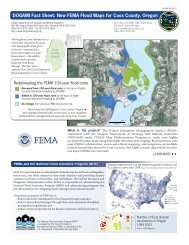Ore Bin / Oregon Geology magazine / journal - Oregon Department ...
Ore Bin / Oregon Geology magazine / journal - Oregon Department ...
Ore Bin / Oregon Geology magazine / journal - Oregon Department ...
Create successful ePaper yourself
Turn your PDF publications into a flip-book with our unique Google optimized e-Paper software.
Recently excavated mammoth tusk on display in Prineville BLM office<br />
A mammoth tusk found eroding from a stream bank near Mitchell<br />
in May 1988 by Merle. Sandra, and Devin Simmons of Eugene (see<br />
cover photo) has been placed on prominent display in the lobby of<br />
the Prineville District Office of the U.S. Bureau of Land Management<br />
(BLM). Merle, a dental technologist, suspected that the rather strange<br />
looking white material was ivory from a tooth and alerted the John<br />
Day Fossil Beds National Monument. The staff there passed a sample<br />
and the information from Simmons along to BLM. Through an interagency<br />
agreement, the Park Service helped prOiect the tusk by<br />
applying glues to the weathered specimen and patrolling the location<br />
until the tusk could be excavated by paleontologist Dave Taylor of<br />
the Northwest Natural History Association.<br />
According to Taylor, the tusk is a greatly enlarged incisor tooth<br />
that most likely belonged to the columbian mammoth, or Mammuthus<br />
columbi. The columbian mammoth was large, even for an elephant,<br />
allaining a height of up to 13 ft at the shoulders. It was common<br />
during late Pleistocene time and ranged throughout North and Central<br />
America.<br />
BLM archaeologist Suzanne Crowley Thomas stated that the tusk,<br />
which was found in stream gravels with its tip lodged against a large<br />
boulder, was all that was left of a carcass that had probably washed<br />
downstream long ago.<br />
The tusk was found on land in Wheeler County that was recently<br />
acquired by BLM in the Sutton Mountain land exchange. The area<br />
is known to be rich in paleontological resources dated 34 10 54 million<br />
years old. This find is unique, however, because it is so recent.<br />
Before the tusk could be excavated, 6 ft of earth had to be removed<br />
from above the fossil, and space to work had to be cut into the<br />
steep hillside. Taylor, who led the excavation one hot weekend in<br />
August 1988, was assisted in the process by archaeologist Thomas<br />
and volunteers Bob Tavemia, Scott Thomas, and Merle and Sandra<br />
Simmons.<br />
The tusk was exposed, and plaster-soaked burlap strips were applied<br />
to form a protective jacket. Boards were added to stabilize the tusk,<br />
and finally the whole package was lifted onto a stretcher and carried<br />
downhill. The tusk then spent the next few months in a laboratory<br />
at Portland State University, while Taylor cut and peeled away the<br />
plaster jacket, applied more glues. and filled in some of the missing<br />
surface with plaster.<br />
After its return to central <strong>Ore</strong>gon, the tusk was placed in a specially<br />
designed case in the lobby of the Prineville BLM District Office<br />
along with photographs and descriptions of the excavation. The Bridge<br />
Creek mammoth tusk exhibit is proving to be a popular attraction<br />
Sandra Simmons helping in excavating the mammoth lusk she and<br />
her family found near Mitchell in 1988.<br />
and has been viewed by several hundred visitors since its unveiling<br />
on April 19, 1989.<br />
This tusk is a classic example of the way in which private citizens<br />
who make an important scientific discovery on public lands can report<br />
the find to the appropriate land managing agency or to a member<br />
of the professional community, thereby assuring that the discovery<br />
will be properly treated and preserved for all to study and enjoy.<br />
The casual use and collection of fossils have long been recognized<br />
as legitimate activities on public lands. Some restrictions do exist,<br />
however, which provide for the mamagement and protection of fossils<br />
of major scientific value. Generally, common invertebrate and plant<br />
fossils may be collected by private individuals without a permit. Exceptions<br />
can occur when the fossils are of high scientific value. Vertebrate<br />
fossils generally may be collected under permits issued by<br />
BLM or other appropriate authorities, and these permits are issued<br />
only to bona-fide scientific researchers and institutions.<br />
Opportunities are available, however, for private individuals to<br />
participate in scientific field studies through volunteer work with active<br />
research organizations such as colleges, universities, conservation organizations,<br />
and museums. For those who want 10 participate, there<br />
is ample opportunity to dig and learn through these organized research<br />
programs.<br />
BUvf Ne .... s. <strong>Ore</strong>gon and Washington<br />
(Col1linued from previous page)<br />
tending through '1984 (Neuendorf and Yost,<br />
1987). The <strong>Department</strong> has a noncirculating<br />
library of current and out-of-print periodicals,<br />
theses and dissertations, and published and unpublished<br />
repons, including reports written for<br />
the War Officc during World War II. The <strong>Department</strong><br />
also maintains files of unpUblished<br />
information on most of the commodities lisled<br />
in Table I. Summaries of these commodities<br />
were published in the Dt;partment's Bulletin<br />
64, Mineral and Waler Resources of <strong>Ore</strong>gon<br />
(Weissenborn, 1969). Comprehensive <strong>Department</strong><br />
studies on talc and bentonite have been<br />
published recently; a limestone survey is in<br />
press; a silica summary is in progress; and similar<br />
studies of other commodities are planned<br />
for future work.<br />
RE FE RENCES CITED<br />
Bates. R.L.. 1969 (1St ed. 1960). <strong>Geology</strong> of the<br />
industrial rocks and minerals, New York, Dover<br />
P ubli~ations. 459 p.<br />
Ferns. ML and Ramp, L.. 1988, Investigations of<br />
talc in <strong>Ore</strong>gon: <strong>Ore</strong>gon <strong>Department</strong> of <strong>Geology</strong><br />
and Mineral Industries Special Paper 18.52 p ..<br />
4 pis.<br />
Gray. JJ .. Geitgey. R. P .. and Baxter. G.L.. 1989.<br />
Bentonite in <strong>Ore</strong>gon: Oc~urrellCes, analyses, and<br />
economic poIential: <strong>Ore</strong>gon <strong>Department</strong> of <strong>Geology</strong><br />
and Mineral Indusuies Special Paper 20,<br />
28 p .• 3 pis.<br />
Harben. P.W., and Bates. R. L., 1984. <strong>Geology</strong> of<br />
the nonmetallics: New York. Metal Bulletin. Inc.,<br />
392 p.<br />
Industrial Minerals. 1967- : Worcester Park. U.K.,<br />
Metal Bulletin Journals Ltd.<br />
Lefond. SJ .. and othen. eels .. 1983. industrial minerals<br />
and rocks (nonmetallics other than fuel s),<br />
5th ed.: New York. Society of Mining Engineers<br />
of the American Institute of Mining, Metallurgical.<br />
and Petroleum Engineen. Inc., 2 v .. 1446 p.<br />
Leppert, D.E., 1988, An <strong>Ore</strong>gon cure for Bikini island?<br />
First results from the Zeolite Immobiliution<br />
Experiment: <strong>Ore</strong>gon <strong>Geology</strong>. v. 50. no_<br />
11/12. p. 140-141.<br />
Neuendorf. K.K.E., and Yost, K., eelS., 1987, Bibliography<br />
of the geology and mineral resources<br />
of <strong>Ore</strong>gon, 8th supplement, January I. 1980. to<br />
December 31. 1984: <strong>Ore</strong>gon <strong>Department</strong> of<strong>Geology</strong><br />
and Mineral Industries Bulletin 103, 176 p.<br />
U.S. Bureau of Mines. 1985. Mineral facts and problems.<br />
1985 edition: U.S. BureauofMines Bulletin<br />
675, 956 p.<br />
---1989. Minerals yearbook, 1987: U.S. Bureau<br />
of Mines , 3 v. (Latest year covered; for subsequent<br />
year, single chapters usually are published as preprints.)<br />
Weissenborn, A.E., ed., 1969, Mineral and water resources<br />
of <strong>Ore</strong>gon: <strong>Ore</strong>gon <strong>Department</strong> of <strong>Geology</strong><br />
and Mineral Industries Bulletin 64, 462<br />
0<br />
O REGON GEOLOGY, VOLUME 51, NUMBE R 6, NO VEMBER 1989<br />
129


